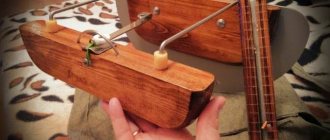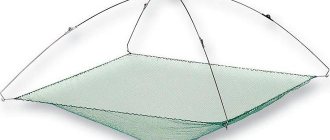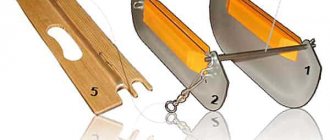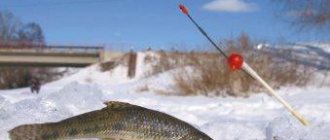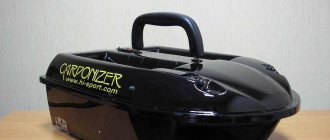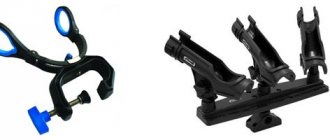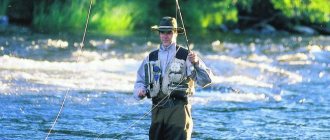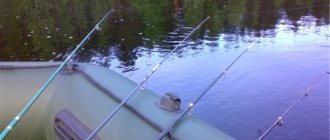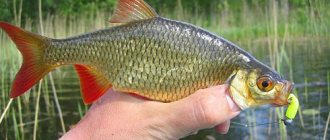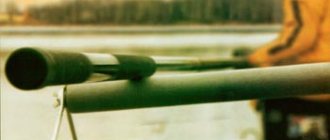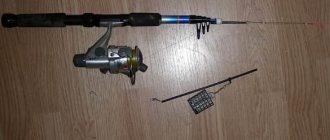When, on whom and where is the boat used?
The ship is used at such times:
- The boat can be used from the beginning of the summer season until late autumn.
- The best time for fishing is considered to be the morning and the first hours after sunset.
The following types of fish can be caught on a boat:
- Pike.
- Chub.
- Asp.
- Taimen.
- Guster.
- Ide.
- Perch.
The boat can be used in large bodies of water that are not overgrown with algae, such as lakes, rivers and reservoirs. The main thing is that there are no snags or other obstacles for the free passage of the boat.
Advantages of using a boat:
- The ship allows you to deliver complementary food to the desired location, as well as various mixtures to attract fish to the desired location.
- The use of such gear greatly increases the fishing activity of fish.
- By ship you can deliver markers that determine the next area to be fished.
- In hard-to-reach places, the boat can independently deliver bait.
Disadvantages of using a boat:
- Under unfavorable conditions of use (strong wind, large waves, etc.), the boat may capsize or break.
- If the manufacturing technique is incorrect, a homemade boat can be difficult to control and cause a lot of difficulties for the fisherman.
Where is the best place to fish by boat?
This tackle can be used on any water where there is a current or where the wind often blows. It is also convenient to fish with them where there is a lot of algae near the coastline and the use of a fishing rod is difficult.
In some cases, fishermen also use watercraft for fishing with such gear. In order for the “boat” to sail to the required distance, the fisherman only needs to adjust the speed of the boat.
Read! Catching silver carp on a pond
This gear is mainly used to catch predatory insects, so it becomes most effective during the period when insects fly out. It has proven itself especially successful when fishing for pike, perch, and chub.
You can attach any insects to the hook when fishing with a boat, but you can also successfully catch fish using artificial bait.
The principle of operation of the boat
The operating principle of this gear is as follows:
- Due to the fact that the boat has an asymmetrical shape, it can move away from the sides of the boat.
- A special weight is attached to the lower zone of the boat, which balances it so that it is in an upright position.
- Then the tackle is attached to the main line at a short distance from the boat so that the line is stretched and the boat moves slightly to the side.
- When escorting, the food is gradually washed out of the boat, and the fish swims closer to the required fishing spot.
Operating principle of the boat
The operating principle of this boat is based on a kite, but instead of the wind they use the force of water flow. In shape it is not much like a boat, but more like a catamaran. A fishing line or cord with leashes and hooks is tied to one side of it. For sport fishing, the hook limit is no more than 5 pieces. Remember this so that you don’t have problems with the fisheries authorities later.
And so we put our boat on the water and send it sailing against the current, gradually unwinding the fishing line. Having reeled off the desired amount, we keep the boat at a distance and wait for the bite to occur. As soon as the fish is hooked, release the tension and tighten the line again. At this moment, the cord is thrown to the other side and the boat begins to move downstream towards the shore.

Having unhooked the fish, we again throw the line to the other edge and the boat returns to its original position. It should be noted that you should choose places with a clean, empty bank, since you won’t feel comfortable walking through bushes and overgrown shores and unhooking fish. But from the video I think everything will become clear to you.
How to make a boat with your own hands
The classic boat, also called a “water kite,” does not have a very complicated design, so you can make it yourself.
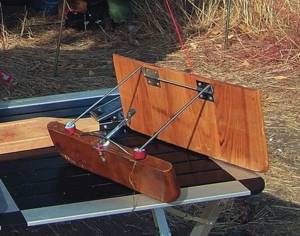
To do this you need to prepare the following materials:
- Two small boards made of deciduous trees (apple, pear, etc.).
- Two aluminum plates.
- Two fishing line clips.
- Swivels.
- Two carbines.
- A stainless steel rod with a diameter of four millimeters.
- Lead strip.
- Elements for fastening.
- Varnish for wood.
This device is manufactured in this way:
- Cut two blanks from wooden boards with a length of twenty-five centimeters and a width of ten centimeters.
- Sharpen the future part of the “nose” of the boat. It should smoothly move to a distance of no more than five centimeters.
- Make a square shape at the back of the boat.
- Drill two holes through for the pins in the middle of the workpieces.
- Using aluminum plates, make L-shaped holders for clothespins.
- Attach the holder with self-tapping screws to the boat ten centimeters from its building part.
- Attach a pin along with a swivel and carabiners in the middle of the boat.
- Open all wooden areas of the boat with two layers of varnish.
- Using a bolt and nut, attach the clothespin to the holder.
- Attach the lead strips to the lower area of the boat (from the end) using self-tapping screws.
- Load the boat and check how it “stands” on the water. When loaded, the entire device should protrude from the water surface by no more than one third.
In addition to the water kite, you can also make another type of boat called “Catamaran”.
To make it, you should prepare the following materials:
- Pine board measuring thirty by fifteen centimeters.
- Two swivels.
- Two metal rods.
- Two leaf springs (to absorb shocks).
- Float (for support).
- Switch with safety bracket.
- Towing line.
- Drying oil.
The principle of manufacturing a catamaran is as follows:
- Give the wooden blank the shape of a boat (sharpen the nose and round the back).
- Attach the redan to the bottom end of the board. It should prevent the boat from falling out during rapid changes in speed of the catamaran.
- Saturate the board with drying oil or cover it with clear wood varnish. It is also advisable to paint it green or blue with varnish before opening it so that it is not so noticeable to the fish.
- Drill a small hole in the middle of the board and insert a lead rivet into it.
- Attach springs at a distance of fifteen centimeters in the upper zone of the end part of the board. Between them, adapt a strip of cork for storing flies and other baits.
- Make a float for support from foam plastic. Attach a groove for a wooden base to its upper part. It should then be adapted to the catamaran springs.
- Make two small oval blanks from foam plastic that will fit the size of the catamaran base and attach them on both sides with screws.
Tackle for fishing on a boat
To fish using a boat, you should use the following gear:
Spinning. It should be quite powerful and have a test of at least two hundred grams.
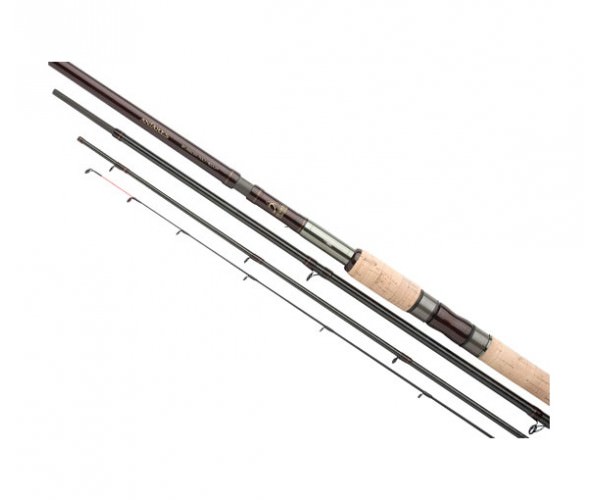
Coil. It is recommended to use an open reel inertia reel, since inertialess reels are not suitable due to their insufficient power.
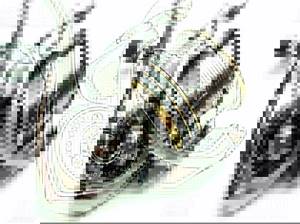
Fishing line. It must be very strong and withstand heavy loads. The diameter of the fishing line must be at least 0.9 mm.
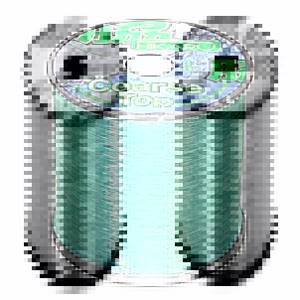
Hooks No. 5-8.
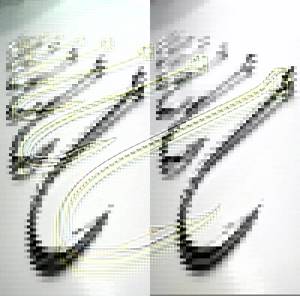
Leashes with a line diameter of 0.20 mm and a length of twenty centimeters.
The boat is attached in this way:
- One end of the main line is attached to the boat using a large carabiner.
- The other end of the fishing line is attached to the boat's reel. The main line along with the leashes is wound around it. The length of the reel should be fifty centimeters, the width – seven centimeters.
- The leashes are attached to the main line in this way: the closer the leash is to the boat, the shorter the length of the leash should be and vice versa, the closer the leash is to the angler, the longer the leashes should be.
How to make tackle
A good example is a fishing boat made from two wooden planks. The best types of wood for gear are beech or oak. It is allowed to use other types of wood, and even plywood. To increase service life, the structure must be additionally treated with water-repellent impregnation.
- Workpieces with a thickness of 12-14 mm are shaped into a trapezoid. The bases of one plank are 340 and 240 mm long, the other ones are 40-50 mm shorter. The sides have a pointed cut on both sides.
- Wooden parts are connected using metal pins. The diameter of the steel bar is 6 mm, length 140-150 mm.
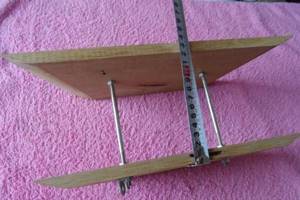
Photo 2. The ship is in the process of production.
Attention! After assembly, you should get a structure with parallel planks. The smaller base of each of them is located at the bottom.
- A bracket is attached to the smaller board for connection to the main line. A reversible fishing boat suggests the possibility of reinstalling the bracket from one end to the other.
- At the last stage of manufacturing the gear, loading is done. It is selected in such a way that in the working position there is 20-30 mm of the structure above the water. It is most convenient to load the boat with lead plates attached to the lower end of the wooden parts.
- The finished product is attached to the main fishing line. The first leash is tied 50 cm from the boat, and 2-4 more leashes are attached at a similar distance. The equipment of the boat for fishing is completed with a rigid spinning rod and an inertial reel of the “Neva” type.
Important detail! The closer the leash is to the rod, the longer it should be. Ideally you can select the required lengths only on a pond.
Today, anglers successfully make sleds from polystyrene foam, plastic bottles, etc.
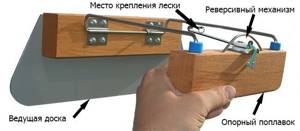
Photo 3. Schematic diagram of installation.
Lures used
The following are used as attachments for boats:
Artificial flies that imitate insects, including various dragonflies, flies and butterflies. Also, they can be wet or dry. Dry baits should easily jump on the water surface, and wet ones should have a bright game with a slight immersion.
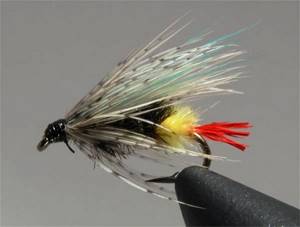
Spoons (spinning spoons). They must have a suitable size and weight so that when retrieved they do not stretch on the very surface of the water surface, but give good play when immersed at least forty centimeters.
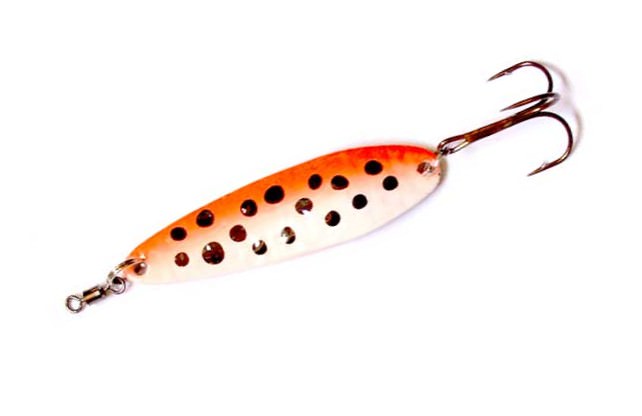
Boat fishing technique
The fishing technique includes the following steps:
- Launch.
- Wiring (in standing and running water).
- Fishing.
Launch
The launch of this gear is done according to the following scheme of actions:
- Adjust the position of the boat for launch and stick the flies into the cork strip at the upper end of the main board.
- Attach the tow line clip to the switch safety bracket.
- Place the spinning rod on a coastal area, not far from the water.
- Attach the fishing line to the fastener, first unfasten it from the fuse.
- Release the towing line from the elastic band.
- Starting with the first fastener, begin to release the flies one by one.
- When all the flies are on the water, you should check the float for support and position the boat at a slight angle from the direction of the current.
- Take the spinning rod and turn off the reel brake. Unwind the line fifteen meters and press the reel tightly.
- Use the tip of the fishing rod to push the boat into the water.
- Start moving the boat in the desired direction, while simultaneously releasing the fishing line to the required length.
Wiring (in still water)
Wiring in standing water has its own characteristics. The force that moves the boat away from the shore should be created here not by the current, but by the movements of the fisherman, so the latter must constantly move slowly along the shore to ensure the necessary tension in the fishing line.
It is carried out according to this principle:
- The fisherman must walk slowly along the coastal area, making short stops. At the same time, he must reel in the fishing line with a reel.
- Then, when the boat sails closer to the shore, you should switch the reverse simultaneously with the fisherman moving in the opposite direction.
- The length of the fishing line must be controlled and set in such a way that the flies pass close to the already fished area of the reservoir.
Piloting a boat in running water
On reservoirs, fishing in running water is done using dry and wet flies.
Let's look at wiring with dry flies:
- The boat should be guided downstream, since it is thus in front of the fisherman, which makes the process of adjusting it easier.
- You should hold the fishing rod with your right hand, and tighten the reel spool tightly with your thumb.
- The line must be kept taut at all times.
- Wiring should be done close to the shore, moving the boat with short pauses along the same line. This will make it possible to fish a large area near the shore with flies.
You should navigate a boat using a wet fly as follows:
- Lower the boat downstream.
- Lower the fishing rod horizontally along the shore.
- Then the fisherman must begin to move along the coastal zone at the speed of the current.
- Place the towing line on the water and bend it in an arc. Then drive it under the surface of the water with the current.
- Next, you need to make sure that the towing line does not go higher than the surface of the water, otherwise the wiring will be damaged and will have to be re-done.
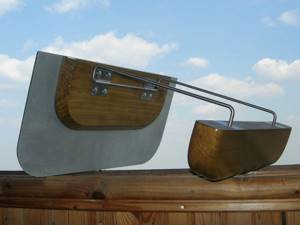
Fishing
Fishing has the following features:
- When fishing, the fishing rod must be kept in a horizontal position. This reduces the angle between the leash and the towing line. If the rod is in any other position, this may contribute to the fly being pulled out of the catch's mouth.
- Since in the first fifteen seconds the fish is not yet aware of the danger and does not resist, the fisherman must use them for fishing. During this time, he needs to have time to put the reel on the brake, put the fishing rod on the shore and grab the catch with his hands.
Depending on the place of fishing, the wiring of the boat has the following features:
- You should know that bodies of water that do not have enough space are not suitable for launching a boat. Also, you should not take risks and launch the boat from shores that are densely overgrown with algae.
- It is better to launch the boat in areas where the bottom is uneven and there are sharp changes in depth, since this is where fish most often gather. Wiring in such places should be done at medium speed in order to attract, but not scare away the fish.
- Low banks should be fished immediately, gradually moving to deeper areas. This way you won't miss large concentrations of fish.
- As practice shows, fish bite best on flies at a depth of no more than one meter, so there is simply no point in taking the boat to too great depths.
- If the river is small, then you need to fish it from the opposite bank, smoothly driving the fish towards the bank you are on. Thus, the boat will bring with it a lot of catch.
- If the fishing takes place on an open lake, where there are no bushes or other vegetation, then the fisherman must wear special camouflage clothing in muted tones so as not to scare away the fish.
Depending on the type of fish, the wiring method has the following features:
- When catching an asp, you should know that it always swallows the fly very quickly. This can be determined by the characteristic splash of water under the location of the flies, and the strong jerk that follows. In order to successfully pull out a caught asp, the fisherman must make several jerks with the fishing line to slightly weaken the resistance of the fish. After this, the asp weakens a little and approaches the shore more calmly. Its gatherings happen infrequently and are mainly due to the fault of the fisherman.
- The chub is always interested in flies, but pecks at them rather restrainedly. His bite can be seen by the splash above the fly, but there will be no jerk on the line. In such cases, you should take your time and wait for another bite so that the chub is sure to catch the hook. When he swallows the hook, the fisherman feels strong jerks as the fish begins to resist. When fishing for a chub, it should be positioned on its side so that it loses its strength faster and does not twitch so much. Also, you should know that chub are better caught with a wet fly.
- The ide bite on a fly is very original. First, the fisherman sees waves near one of the flies. Then he makes a sharp jerk and several splashes at once. When swallowing a fly, the ide often does not catch on the sting of the hook, but simply heals strongly with its mouth, so if it is sharply hooked, it can simply spit out the hook and go back into the water. In order to successfully deliver the ide to the shore, you should carefully but quickly pull it up and make several hooks near the shore. In addition, the fisherman must be prepared for the fact that the closer the fish comes to the shore, the stronger and sharper its jerks and resistance become.
- Perch is usually caught on a boat completely by accident in shallow areas of lakes. He grabs the fly quickly, often jumping out of the water after it. Larger perches are caught very rarely with such gear, so they are not of particular interest.
- Pike usually grab a fly in shallow water that is overgrown with low algae. Its bite is also unusual, since the fly suddenly goes under the water, and the towing line sags greatly, which looks like a hook. As a rule, after hooking, the pike does not offer much resistance and is pulled calmly onto land. It is interesting that the pike grabs the fly only with the tip of its jaw, without damaging the leashes from the fishing line.
Catching asp on a boat
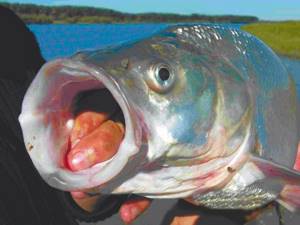
photo by the author
In places frequented by fishermen, he does not always bite on spinning baits, no matter which of them you select. The use of a boat properly equipped with leashes can make the fishing result more predictable. The main thing is that the bait bait on the hook moves naturally in the water and, if possible, is located as far away from the hull of the boat as possible. Also, the fisherman’s presence on the shore or some hydraulic structure should be invisible.
Asp on large rivers usually gather in large flocks closer to autumn. This makes it easier for him to organize a roundup hunt for bleak and other mounted fish. The flock, having discovered a school of small things, surrounds it on all sides, and if it was at the bottom or in the water column, it pushes it towards the surface. Then the asps begin to actively suppress the compacted school with their powerful tails and eat the fish. The feasts of river corsairs can be very impressive! On medium-sized rivers, for example, the Oka or Kama, fishing for asp on “boilers” is sometimes accessible from the shore, but still, on medium-sized and especially large rivers, you often cannot do without a boat.
Searching for an asp involves significant movements around a body of water and looking out for seagulls, as well as breakers on the water. For this, a boat or boat with a not very noisy engine and binoculars are best suited. The dense circling of seagulls above the water may indicate that you have discovered an asp “cauldron”, which most often has an elongated shape. Its area can vary greatly and depends on the size of the school of forage fish.
When approaching the “cauldron”, the boat’s engine should be turned off 150-200 m before the location of the fish, and then float downstream or approach with oars. Now you should watch carefully. Having realized where the asp is most concentrated, the boat is turned against the current and the bow anchor is dropped so that later, releasing the rope, you can go lower and find yourself on the side of the “cauldron” (it is necessary, of course, to have a large supply of rope). Having chosen a place you like, you must lower the second anchor so that the boat does not toss in the current. You cannot approach the “cauldron” closer than 70 m, otherwise the flock will get scared and move away.
The boat, baited with live bait, is launched across the current, bypassing the area where the asp is fighting (from behind). In this case, they are caught on leashes attached to the main line at a distance of at least 5-8 m from the boat, otherwise the latter can frighten the fish with its impressive appearance. The leashes should have a diameter of 0.3-0.35 mm, single hooks, No. 3-6, with a long shank. To attract the attention of the asp, live bait should be occasionally raised above the water. The catamaran boat model is most suitable for this fishing technique - it is less noticeable.
There are designs of boats, including a mast-mounted one, that are launched downstream from the boat. They should not be too massive so as not to arouse the suspicion of such a cautious predator as the asp. This is especially important if it is necessary to stop the boat at promising points. In this case, the current will put pressure on the body, and the unnatural position of the object on the water will alert the fish. In the design of a mast boat, two types of leash equipment are used. The first is when the leashes are attached to a fishing line in front of the boat. The second is when the leash comes from the hull of the boat. In the first case, the leashes must be placed as far as possible from the hull of the boat. In the second case, a long leash of at least 5 m is used, additionally equipped with a horizontal float that is hardly noticeable on the water. When launching a boat into the water from a boat, using the current, unfold a long leash so that it, along with the baited fry, floats right in front of the boat. To do this, pull the fishing line to slightly slow down the speed. If the boat is ahead of the movement of the additional leash, this will lead to tangling of the equipment.
All leashes are equipped with swivels, which prevents the line from twisting. It is better to take a large bleak or small roach as live bait. Live bait should be located close to the surface of the water. They bait it behind the upper palate, closer to the hard part of the head, otherwise it will not sit firmly on the hook.
The asp bite is sharp. Usually he captures live bait right away. When dragged to the boat, the asp violently resists, so it is advisable to purchase hooks, swivels and snap hooks for equipment from well-known manufacturers.
When catching asp on a boat, you can also use artificial baits - wabik, vibrotails, twisters. Especially artificial baits showed themselves well when fishing with a boat on the Lower Volga. Vabik is suitable white-black or white-green; high-quality wabik is made from goat hair. It needs a tee No. 8-13.
On medium and small rivers, medium-sized asps, up to about 1 kg, are well caught on a boat. They bite well on various flying insects: dragonflies, butterflies that emerge from aquatic larvae such as cuttlefish, barnacles, caddisflies, mayflies, etc. One of the best baits for a medium-sized asp is the gadfly. Sometimes, in order for the bait to be better visible on the water, it is worth putting two gadflies on the hook at once, but so that the insects continue to move and work with their wings. Any natural fluctuations in the water attract the attention of a predator. Small butterflies also need to be put on the hook several at a time.
On small rivers, Upa, Zusha, Ugra, Shosha, you can successfully use an inconspicuous boat drifting downstream. Usually this is walking fishing. You go downstream, choosing the bank of the river from which it is more convenient to launch the boat. Any protruding toe or just a regular shore with a comfortable step near the water, from which comes a powerful breaker jet, suitable for releasing the boat, is suitable for the angler’s position.
Of course, the prospects for the habitat of the asp play a big role. Often the asp, alone or in small flocks, stays in the area of sand deposits, islands of vegetation, near the habitats of the fry in shallow water. That's where the boat needs to go. It is most convenient to fish from bridges and piers, which allow you to bring the gear to the main stream. On the tributaries of the Oka there are many old dilapidated bridges with influxes of debris near the piles. In the passages between the rubble, a powerful jet is created, at the end of which an asp can be held. This is where the equipment should be supplied on the boat.
The best time for fishing on a drifting boat with insect bait is when various dragonflies, midges, and butterflies fly low over the water. Typically, mass emergence of insects is typical for quiet, warm August evenings. Such moments of fishing are memorable, even if the catch is small. Alone, on the eve of autumn, you acutely feel the harmony of the world around you and understand the meaning of silence... Grasshoppers are chattering along the banks, the smell of herbs is soothing, the movement of water is soothing...
Sometimes an asp, like sabrefish, strikes fry on the edge of shallow sand spits, where there may be a snag washed out by sand. Bleak and verkhovka like to stay in such places - here they find shelter from predators. The boat should be navigated, focusing on the fish rising above the surface.
When catching single seasoned asps, you should remember that they always stay unnoticed - in the shadows, somewhere under a cliff, at the edge, as well as near shallow water where the fry gather and where you can suddenly jump out, catching the fish by surprise. Particularly large asps like to instantly burst into lagoons or other limited areas, from where the fry cannot quickly go to depth. In the lower reaches of the Volga, on Akhtuba, this fish often hunts in coastal gutters. Here the asp jumps out from the depths, anticipating where a flock of bleaks will rush. Often large fish choose depressions between sandy terraces, both in shallow and deep water. But it is more difficult for them to hunt at depth. When launching the boat, you need to try to do the wiring so that the live bait attached to the hook goes from the depths to the shallows.
Often the asp hunts for the ends of sandy peninsulas and spits, behind which there is often an immediate drop to depth. His hunting route always lies along the cliff.
In the lower reaches of many rivers, good places for catching asp can be semi-flooded bushes, which are often found under wooded steep banks. But, as a rule, small fish stay here in small schools, no more than 5-7 individuals. Usually the asp can be caught from under the very branches. Therefore, it is more effective to use equipment with an end leash coming from the boat. True, this method of fishing can be fraught with snags, as a result of which the flock usually leaves.
Alexey Khludov October 25, 2011 at 00:00
Anglers' mistakes when fishing with boats
The most common mistakes made by fishermen when fishing by boat include the following:
- Fishermen forget that they should not launch the boat close to the shore, where it is very shallow.
- They do not control the position of the towing line, which leads to it flapping in the water.
- The tackle is taken too far from the coastal zone.
- They use the boat on sunny days, when the shadow from the fishing line scares the fish.
- When fishing for a catch, they do not hold the fishing rod in a vertical position.
- When fishing, fishermen hold the line with crayfish.
Blitz tips
- Before attaching the fly, you should lubricate the hook with a special moisture-resistant glue, since under the fly the metal from which the hooks are made will quickly rust and lose its strength.
- If you notice that the fish are biting more on one fly, then you need to replace all other baits with the same ones.
- It is better to attach flies to a towing line using the double loop method, since this takes the least time and securely holds the bait.
- The flies on the boat must constantly move. No fish will bite on a stationary bait that simply floats through the water.
- In order to make the flies move, you should raise and lower the fishing rod, then they will take off and fall back onto the water. This will help improve the bite.
